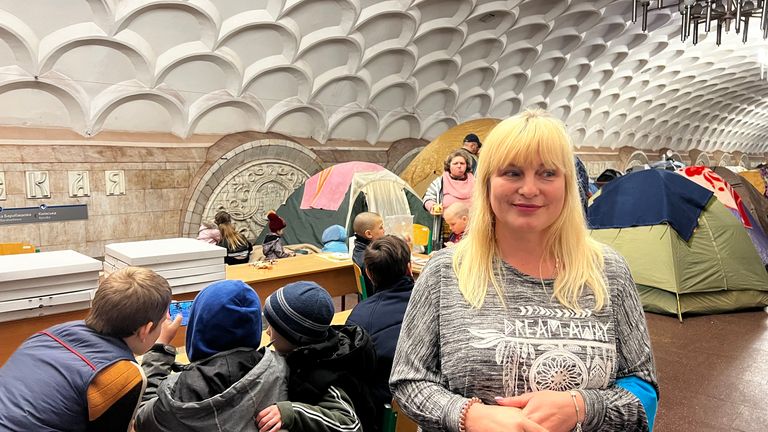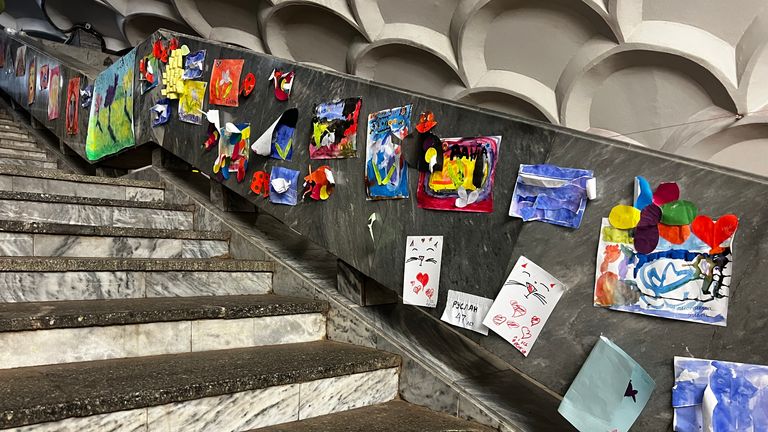[ad_1]
Hundreds of children survive underground in Kharkiv, where they have been sheltering for two months in a city under constant attack.
A metro station is now their home, school, playground and refuge. It is as safe as it gets in Ukraine’s second city just 20 miles from the Russian border, but 12-year-old Nicole Bulizhenko wants to tell us it is no life at all.
“I can’t express how worried I am. It’s so painful. I worry about everyone I love,” she says.
When asked about the people attacking her city, Nicole simply says: “They are not human.”
Her cousin, Lisa, is also 12 years old and she sits beside Nicole, squeezing her hand in support. Nicole’s older sister, in her twenties, watches on with her own child, aged five.
Their parents are still living at their home with three dogs. Once a week, if it’s safe, the girls are allowed back for a bath.
As she tells us about her life now, it’s clear that the things Nicole wants to say have become too difficult. Tears are rolling down her face as she explains how there are six of her family still in Kharkiv. It is a glimpse of the harrowing impact the war is having on children here.
The most important person in these young people’s lives on this cold train platform is Iryna Zolotareva, a UNICEF trauma psychologist.
For the last month she has come to this station once a week to lead art therapy sessions, private consultations with families and sing and dance along with the smallest kids who need to let off some steam.
Iryna has sent her own children – and grandchildren – out of the country because she wants to devote her time to help those left behind: those who have seen and heard far too much.
She says the children don’t call it war down here: “They just use the word ‘loud’. They tell me ‘We’re not going outside today, because it’s loud’.”
Each of them has a different type of trauma, she says: “Some of them were actually caught in the shelling or the bombing, some of them had no shelter because their homes got hit.”
As the children beg us to play catch with them and, with seemingly endless energy, run around the desks strewn with books and drawings, Iryna tells us it hasn’t always been like this.
“When I started, the kids were very frightened. We did practically nothing. We didn’t draw, we didn’t write, we didn’t study, there was no education at all. I was just trying to get them to warm up. To get them to eat. To make them feel safe.”
Above ground, their world is in ruins. Hundreds of schools have been reduced to rubble in this war. If they were targets, it is a war crime. If they were collateral damage, it is dangerously reckless.
We visit the remains of one infant school, surrounded by blown out apartments and fresh craters in the dirt. A toy medical set is lying among the shattered glass. The walls of one classroom are scorched black and there are shoes and bags of clothes strewn across what was once a locker room.
In a cramped corner of the metro station, occupying a small space between two emergency exit doors, there is a maths class taking place. This is what lessons look like now and the children are working hard, but towards what kind of future no one really knows.
Nicole’s one-on-one sessions with Iryna help her understand more about the catastrophe engulfing her. Despite the strain of underground life, she is adamant she will not leave Kharkiv.
“I’ve seen and heard everything. But I’m going to stay here until the very end,” she says.
It is not easy for anyone to listen to, especially while the sounds of artillery are unrelenting on the surface. Iryna apologises to us for letting her own emotions show: “I just want to comfort them and make their trauma smaller and smaller and smaller.”
These are bewildered and confused children, frightened by what is happening to their world.
Iryna embraces Nicole. A hug goes a long way here, because sometimes there are simply no words.
[ad_2]












